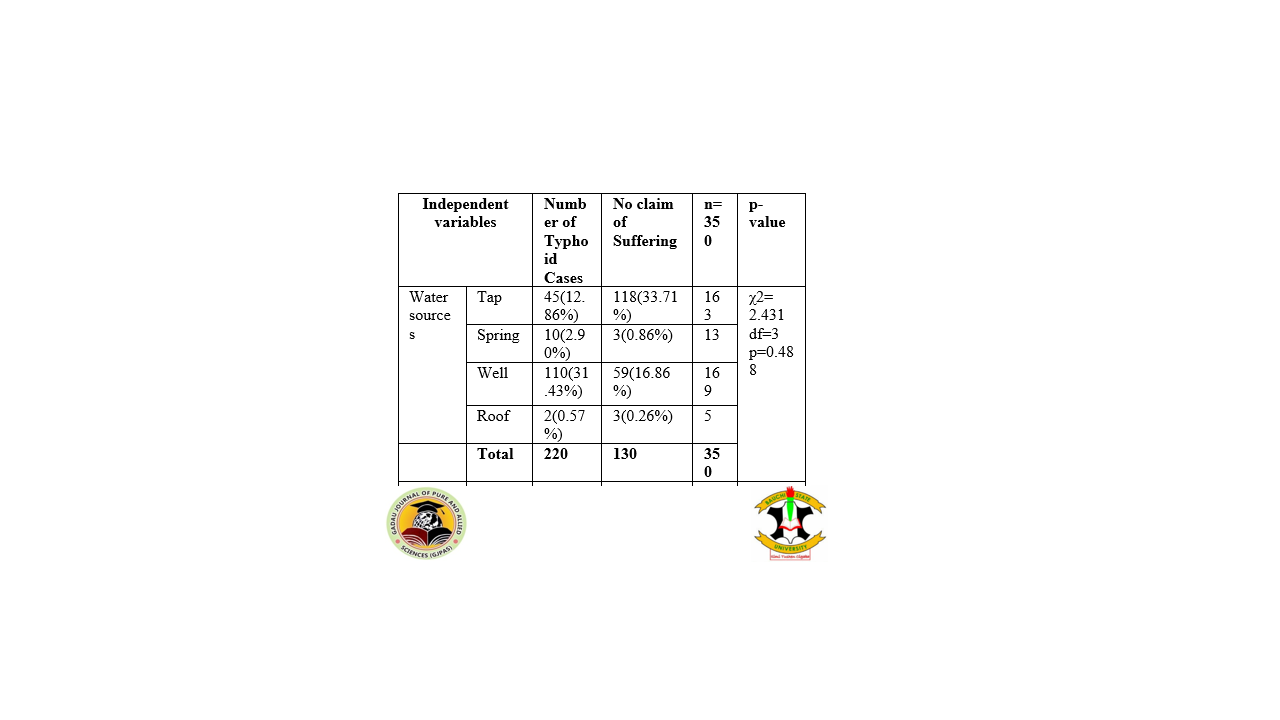Cross-sectional study on prevalence of typhoid and health risk factors among pregnant women attending general hospital, Azare, Bauchi state, Nigeria
DOI:
https://doi.org/10.54117/gjpas.v3i1.115Keywords:
Typhoid, Pregnant, Hospital, Salmonella spp, AzareAbstract
Typhoid fever is among the major prevalent disease in Nigeria due to various interconnected factors such as scarce amenities for handling unwanted products and abuse of antibiotics; these among other factors are responsible for the widespread of typhoid fever affecting both underage children and young adults. This study was a descriptive cross-sectional conducted from September to November, 2023. The study population consisted of adults female age ranged from 18 years and above. A pilot study was conducted which tested the validity and reliability of the instruments. The response rate was 100% for there were no non-consenting respondents. The study variables were independent and dependent. Data was analyzed using SPSS Computer software version 11. The processed data was presented in Tables, Pie chart; and Chi-square test of independence (contingency tables) was used to determine if there was a relationship between control measures of typhoid and it’s occurrence in the study area. The study revealed that those with low level of education suffered from typhoid more than those who had attained a higher level of education and therefore education played a key role in the prevalence of typhoid among pregnant women based on the study. It has been shown that the higher the level of education the more the typhoid prevalence decreased among the adults as in primary, secondary and college levels respectively. The findings of this study also showed that 63% of the pregnant women had suffered from typhoid fever in one or more times in their life time, and only 37% had not. This is a clear indication that typhoid fever is prevalent among pregnant women attending General hospital in Azare. The results showed that those with low level of education were more than 50% and they suffered from typhoid episodes in their lifetime more than those with higher level of education. This study revealed that 63% did not have water storage facility while 37% provided water storage facilities within their households. The results of the study found that 80.2% of the residents had temporary houses, 14.4% had semi-permanent houses and 5.4% had permanent houses. These statistics reveal that most of the residents were poor and that they were vulnerable to poor housing which could promote poor state of sanitation. Poor sanitation practices are a cause of bacterial, viral, protozoa, and helminthic infections. Similarly, on waste collection 82.9% were dissatisfied about it, and 17.1% were satisfied. The main reason of dissatisfaction on waste collection was that it was done unprofessionally (52.9%) and irregularly (36.3%). The majority (47.1%) of the residents of the area under study felt that the drainage systems posed a problem of leaking, 36% felt the problem with drainage was smell and 16.9% felt that drainage system were contaminating their surface water sources.
References
Bhanu, S., Vandana, S. and Archana, S. (2011). Comparative study of diagnostic procedures in Salmonella infection causative agent of typhoid fever: An overview study. International Research Journal of Pharmacy 2 (9), 127-129.
Bhutta, Z. A. (2006). Current concepts in the diagnosis and treatment of typhoid fever. British Medical Journal 333: 78-82.
Bhutta, Z. A. and Mansurali, N. (2009). Rapid serologic diagnosis of pediatric typhoid fever in an endemic area: a prospective comparative evaluation of two dot-enzyme immunoassays and the Widal test. Journal of Tropical Medicine 61: 654-657.
Fisher, A. A., Laing, J. E., Stoeckel, J. E. and Townsend, J.W. (1998) Handbook for Family Planning Operations Research Design. Population Council, New York, USA. 56.
Gilman, R. H., Terminel, M. M., Levine, P., Hernandez, M. K. and Hornick, R. B. (2011). Relative efficacy of blood, urine, rectal swab, bone-marrow, and rose-spot cultures for recovery of Salmonella typhi in typhoid fever. Lancet 1211-1215.
https//en.m.wikipedia.org
Muhammed, K, (2009) The Socio-Economic and Political Transformation of Katagum Emirate 1900 – 1960. Unpublished Research Project, Department of International Studies, Ahmadu Bello University, Zaria. 43.
Mutai, C.C. and Ward M. L. (2000) East African Rainfall and the Tropical Circulation/Convention on Intraseasonal to interannual Time scales. Journal of Climate,13:22; 213-220.
NBS (2009): Report of Population. National Board for Statistics. Monthly Publication. N0. 991: 11.
Nyamwaya, D. Munguti, K. and Akuma, P. (2009). A Guide to Health Promotion through Water and Sanitation. University of Abuja, Nigeria. 16.
James, N. and Phillip, M. (2002). The Official Patients Source book on Typhoid Fever and Health Care. Bauchi, Nigeria. 23-25.
National Population Commission (2006) Report of Nigeria National Population Commission on Census. Population Development Review, 33(1); 206-210.
Orodho, A. J. (2003) Essentials of Educational and Social Science Research Methods. Mazola Publishers, Nairobi. Kenya. 52-54.
Pruss, U. and Corralan, C. (2016). Preventing Diseases through Healthy Environment towards anEestimate of the Environmental Burden of Diseases. World Health Organization, France.
Ray, C. (2012). Epidemic deadly disease through History Typhoid Fever. The Rosen Publishing Group Inc, New York.
Twort, A. Law, F. and Crawley, W. (2010). Water Supply Third edition. Holder and Stonington Limited, London: 79-80.
WHO (2017). Technology for Water Supply and Sanitation in Developing Countries. Report of a WHO Study group technical report serial 742 WHO, Geneva. 21-26.

Downloads
Published
Issue
Section
License
Copyright (c) 2024 Gadau Journal of Pure and Allied Sciences

This work is licensed under a Creative Commons Attribution 4.0 International License.

